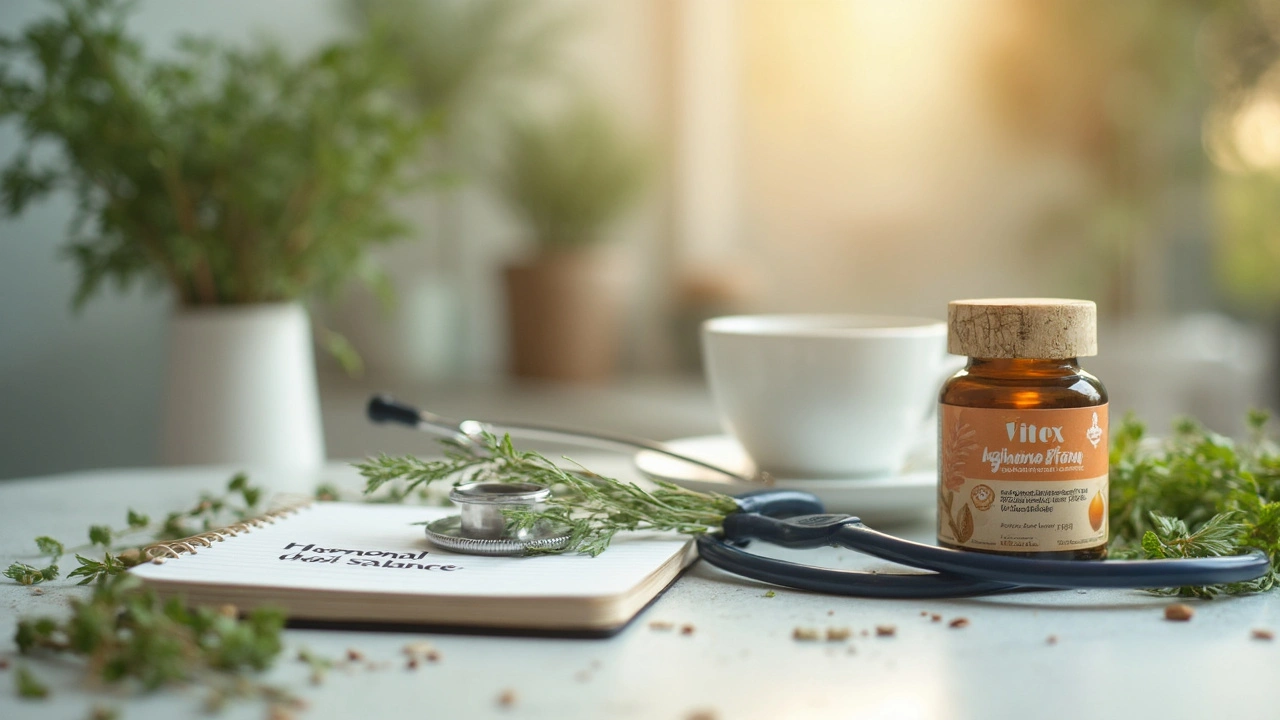Picture trying everything to soothe the chaos of PCOS—taking pills, tracking cycles, switching up your diet—yet still waking up cranky at your hormones. Enter Vitex Agnus-castus, an herbal remedy (also called chaste tree berry) that's been around since Ancient Greece. Back then, it was as popular with women as yoga pants are now. Can this centuries-old plant really help with modern-day PCOS? Or is it just another health fad that doesn’t hold up under real scrutiny?
What is Vitex Agnus-castus and How Does It Work in the Body?
Vitex Agnus-castus grows wild along sunny Mediterranean hillsides, but you can now find it bottled on supplement shelves worldwide. People have used it for everything from period cramps to boosting fertility. The part of the plant that's actually used in supplements—the berry—contains compounds that interact directly with the brain’s hormone control center: the pituitary gland. That’s where the real magic (and potential headaches) happens for PCOS.
Here’s where things get interesting. Unlike common medications for PCOS (like metformin or birth control), Vitex doesn’t act like a hormone itself. Instead, it seems to gently nudge the body to balance existing hormones. Researchers have noticed that certain compounds in the berry, particularly agnuside and casticin, can influence dopamine—a brain chemical that, in turn, reduces prolactin. Prolactin’s great for breastfeeding but usually unhelpful for hormone-challenged women who aren’t postpartum. Lowering it can help regulate menstrual cycles and possibly support ovulation (the holy grail for many women with PCOS).
On top of that, some studies suggest Vitex might have a light effect on progesterone by indirectly telling the body to make more of it. Women with PCOS often struggle with too little progesterone and too much estrogen, causing heavy, unpredictable periods and mood swings. All of that hormonal see-sawing ties together with why so many are curious if this little berry could help calm PCOS symptoms.
Here’s a quick snapshot of common compounds in Vitex and their supposed effects:
| Compound | Possible Effect |
|---|---|
| Agnuside | Lowers prolactin |
| Casticin | Supports dopamine release |
| Flavonoids | Mild anti-inflammatory |
If you think that all sounds promising, you’re not alone. Supplements with Vitex now get snapped up by anyone hoping to control PMS, PMDD, or *polycystic ovary syndrome*—but does the actual evidence keep up with the buzz?
PCOS: The Real Struggle and What’s at Stake
It’s a lot more than skipped periods or embarrassing chin hairs. PCOS (polycystic ovary syndrome) throws hormones into high drama. It affects about 1 in 10 women—although some recent reports say it could be closer to 15% depending on how you diagnose it. This is not just a reproductive thing: it messes with insulin, skin, weight, and even mental clarity. If you’ve got PCOS, you know the drill—maybe you’ve spent too many mornings Googling how to jumpstart a sluggish ovary or tried every “hormone hack” on TikTok.
The hormonal mess comes mainly from an overproduction of androgens (like testosterone) and a resistance to insulin, which creates a feedback loop: high androgens cause the ovaries to stall when trying to release an egg, leading to irregular cycles and often tiny cysts that show up in an ultrasound. The official list of symptoms matches what you hear from real people: hair loss, hair where you don’t want it, acne that laughs in the face of spot treatments, crazy cycles, weight that won’t budge, and mood swings that make you swear your brain is plotting against you.
If that sounds overwhelming, it really is—and that’s exactly why the search for safer, natural relief is so persistent. The “go-to” prescriptions—birth control pills or drugs like spironolactone and metformin—help some people. But these can bring their own drama—think side effects, long-term risks, and sometimes no real fix for ovulation or future fertility hopes. That’s where the natural route, herbs like Vitex Agnus-castus included, comes into play. The idea of encouraging your body to heal itself instead of hammering your hormones with synthetic drugs sounds pretty inviting, right?

What Does Research Say About Vitex Agnus-castus for PCOS?
You’ll hear influencer testimonials about Vitex: “It fixed my period in two months!” “I finally ovulated!” “My skin looks better!” But if you dig into the research, things look both intriguing and a little fuzzy. While there are solid studies on Vitex for PMS and general cycle regulation, only a handful are laser-focused just on PCOS. Even then, the sample sizes are pretty small or the results show more subtle benefits than earth-shaking transformations.
One 2017 study split 96 women with PCOS into two groups: half took Vitex, the other half got placebo. After three months, the Vitex group showed a significant improvement in cycle regularity and a noticeable drop in prolactin levels. That’s a win, but ovulation wasn’t restored in every single case—plus, some women still experienced wonky cycles or no change at all.
Another real-world scoop: some gynecologists in Germany and the UK actually recommend Vitex for irregular cycles connected to mild hormonal imbalances—not necessarily full-blown PCOS, but women who aren’t ovulating consistently or have high prolactin. There are also animal studies suggesting Vitex might reduce ovarian cyst development and tune up insulin sensitivity. But before you get too excited, rats are not humans, and our bodies handle hormones differently, so it’s not a slam-dunk substitute for clinical research.
For a full picture, take a look at this summary:
| Study (Year) | Participants | Main Finding |
|---|---|---|
| Gerhard et al. (1998) | 52 women w/ PCOS | Improved luteal phase defects and cycle length |
| Jelodar et al. (2018) | Animal study | Reduced ovarian cysts in rats, better blood sugar |
| Pourmasumi et al. (2017) | 96 women w/ PCOS | Lower prolactin, better cycle regulation |
If there’s anything clear, it’s that Vitex Agnus-castus isn’t a magic fix, but it might offer gentle support, especially for cycle regulation. Large-scale human trials are still missing from the story, so take broadcasted “miracle cures” with a pinch of skepticism and look for real patterns.
How to Use Vitex Agnus-castus for PCOS: Tips and What You Should Know
If you’re thinking about adding Vitex to your PCOS arsenal, start slow and do your homework. Most supplements come in capsules, tinctures, or teas. Doses that show up most in studies hover between 20–40 mg a day of agnuside—although exact dosages vary, since supplement quality isn’t standardized. Pro tip: Look for brands that provide a breakdown of active compounds and batch test for purity. Avoid “miracle blends” with a sprinkle of Vitex and lots of fillers.
Best time to start? Many women begin right after their period ends, which lines up with how Vitex can support the body’s natural progesterone production in the second half of the cycle. Stick with it—any herbal remedy (especially one that acts by nudging your own hormones) takes time. Real changes can take 3–6 months, so patience is a big part of the equation. Don’t double your dose if you don’t see results in a week.
Here’s a quick run-down of tips if you’re curious about trying Vitex:
- Always talk to a doctor, preferably someone who knows about supplements, before starting Vitex. It can interact with hormonal meds and isn’t for everyone.
- Give it at least 3 cycles to judge any impact. Set reminders on your phone for consistency.
- If you skip a dose, just pick up where you left off. No need to “catch up.”
- Keep a journal—jot down cycle dates, symptoms, and mood swings to help spot subtle shifts.
- Don’t mix Vitex with fertility drugs unless a fertility specialist okays it.
- If pregnancy is your goal, tell your doctor as soon as you get a positive test. Some experts recommend stopping Vitex in early pregnancy, since there’s limited safety data.
- Pace yourself. If you feel weird (nausea, worse headaches, skin flares), take a break and reassess.
Supplements are not regulated nearly as strictly as prescription meds. That means quality brands really matter. If you want an easy starting point, look for German or Swiss-made options, since those countries regulate herbals a bit more tightly, or trusted US companies that show independent test results.

Possible Risks, Side Effects, and When to Skip Vitex
Every supplement—even so-called natural ones—can bring side effects. For Vitex, the side effects are usually mild but not zero. They can include stomach upset, dizziness, weird dreams, more acne (usually in the first weeks), or headaches. If you have a sensitive stomach, try taking it with food.
Here’s who should probably skip Vitex without a long talk with a doctor: Anyone with hormone-sensitive cancers (like breast or ovarian), those on dopamine-enhancing drugs (such as for Parkinson’s), or anyone using IVF medications. If you’re actively trying to conceive, double-check with your OB-GYN, especially if you just started other fertility treatments.
For the data nerds, about 5% of users report side effects—mostly mild but sometimes enough to make people stop the supplement. In rare cases, allergic reactions or menstrual cycle changes can get more dramatic, such as months without a period or unusually heavy bleeding.
One more tip: If you have PCOS but your cycles are still fairly regular, or if your main struggle is insulin resistance, Vitex might not be your best first step. Research and anecdote point most strongly toward benefits for women with high prolactin or stubbornly irregular, absent periods—not those with more classic “male hormone” symptoms or blood sugar drama.
Pregnant or breastfeeding? Skip Vitex. While there’s no clear evidence of harm, there’s no proof of safety either—err on the side of caution.
If you’re already on prescribed hormone meds or have a complicated endocrine picture (think thyroid issues, unusual adrenal symptoms), always loop in a provider. Herbs can be potent, and they don’t work in a vacuum.
If you have any doubts, listen to your body and don’t chase trends just because they’re all over your social media feed. Health is personal—and sometimes slow and steady really does win the race.





